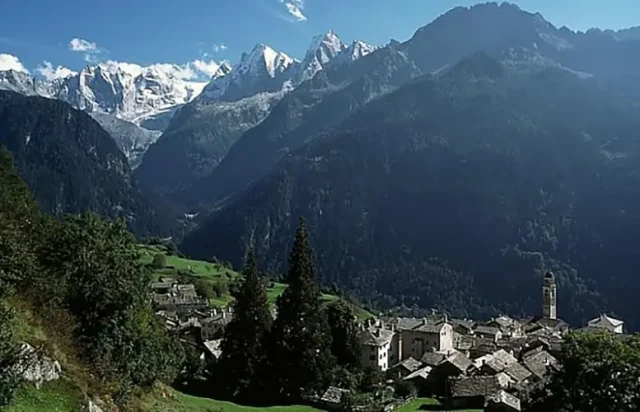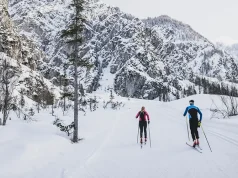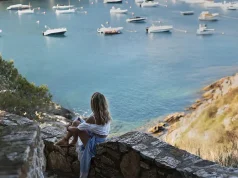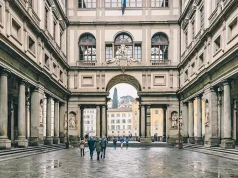
At the far end of Val Bregaglia, where Switzerland leans toward Italy, the village of Soglio stands high above the valley floor. It rests on a ridge surrounded by chestnut woods and cliffs, facing the granite peaks of the Sciora range. The houses are made of stone, their walls thick, their gardens filled with figs and roses.
The air here feels thin but kind. Bells sound softly from a small church tower, echoing through the valley, and the scent of wood smoke drifts between narrow alleys. The village seems to hold its breath, as if aware that any movement might disturb the balance between mountain and light.
The Light That Stays
Soglio has long been called “the gateway to paradise,” though the name feels too grand for its quiet grace. The light alone explains it. Morning arrives slowly, creeping across the cliffs until the first roofs begin to shine. By afternoon, the sun fills the gardens and terraces with warmth, and the shadows of the peaks stretch long and blue across the walls.
Painters came here in the nineteenth century and never really left. Giovanni Segantini, the Italian symbolist, found his vision in this valley. He painted the mountains not as scenery but as spirit, turning light and labor into something sacred. Standing where he once stood, you understand why. The landscape seems composed, as though the world had decided to arrange itself for observation.
Even without canvas or brush, you begin to see like a painter — tracing color, noticing shadow, finding beauty in the smallest contrasts.
The Architecture of Quiet
The houses of Soglio are solid, built for survival but softened by age. Slate roofs, narrow windows, doorways worn by centuries of use. Between them run alleys of stone polished smooth by rain and footsteps. The village feels intact, untouched by haste.
At its heart stands the Palazzo Salis, once the home of a noble family, now an inn with ceilings painted in faded frescoes. From its terrace, you can look across the valley to where clouds cling to the peaks. The air is so clear that every detail seems close enough to touch — the folds of rock, the silver threads of waterfalls, the green terraces far below.
Even in silence, the village hums with the sound of life continuing at its own rhythm: the faint clang of a cowbell, the creak of a wooden gate, the soft rush of wind against the walls.
The Road to the Valley
The journey to Soglio feels like an act of leaving one world for another. The road rises steeply through the forest, turning again and again until the trees thin and the view opens. Each curve reveals more of the valley below — the river, the fields, the line of mountains in the distance.
The road itself is narrow and slow, following the contours of the land. Many Switzerland cycling tours include the Bregaglia Valley in their routes, tracing the road from St. Moritz through Maloja Pass and down toward Chiavenna. For cyclists, this is a place of rhythm rather than challenge — long descents through forests, gentle climbs past stone villages, the sound of water never far away.
Those who reach Soglio by bicycle often speak of the approach as a kind of arrival into stillness. The air cools, the valley widens, and the light takes on a clarity that seems unique to this corner of Switzerland.
The Valley Below
From the terrace of the village, the view stretches over Val Bregaglia — a landscape of stone and shadow. The river flows pale and fast through the valley floor, bordered by meadows and chestnut trees. The houses below seem almost part of the land itself, their roofs blending into the slopes.
Walking down toward the forest, the path passes through terraces where chestnuts still grow in small groves. The trees are centuries old, their trunks twisted and hollow. Each autumn, the people of the valley gather the nuts, drying and grinding them into flour as their ancestors did. The rhythm of the year is measured by harvest and snow.
The valley feels both remote and complete. It is a place that exists on its own terms, quietly sustaining itself without spectacle.
The Shadow of Segantini
Giovanni Segantini’s legacy still shapes how the valley is seen. His paintings captured this region not as backdrop but as subject — the labor of shepherds, the purity of air, the golden curve of evening light on stone. His studio remains in Maloja, at the upper end of the valley, where visitors can still see the sketches and studies he made while preparing his final works.
Segantini died young, painting in the mountains above Soglio. The locals say the last thing he saw was the light over the Sciora peaks. That same light returns every evening, brushing the cliffs with the color of copper and ash. Watching it, you understand why he stayed — and why others continue to come.
The Sound of Evening
When the sun lowers behind the peaks, the air changes. The bells from the church mark the hour, and the first shadows slide across the cobblestones. Smoke rises from chimneys, carrying the smell of wood and chestnut.
The sky deepens to blue, and the valley below begins to fade. In the half-light, the mountains lose their edges and become silhouettes. The only sounds are the river far below and the faint rustle of wind through the chestnut leaves.
Even the people of Soglio move more quietly at this hour, as if the day itself were asking for silence. The rhythm of the place becomes pure — simple, slow, complete.
The Shape of Stillness
Soglio’s beauty lies not in grandeur but in its proportions. Everything fits: the line of a roof, the curve of a path, the way light rests on a wall. It feels less like a village than a composition, a harmony of stone, sky, and sound.
Visitors often describe it as timeless, but that is not quite true. Time moves here, just differently — stretched and softened, measured in changes of light rather than hours. The same could be said of the valley itself, where seasons pass quietly, each one folding into the next.
Standing at the edge of the terrace as evening falls, you realize that nothing in Soglio demands your attention. It only invites it.





